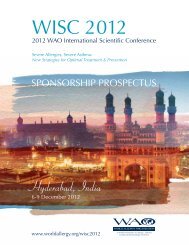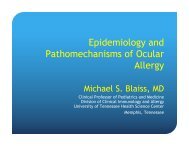Dubai Final-v20.indd - World Allergy Organization
Dubai Final-v20.indd - World Allergy Organization
Dubai Final-v20.indd - World Allergy Organization
You also want an ePaper? Increase the reach of your titles
YUMPU automatically turns print PDFs into web optimized ePapers that Google loves.
ABstrACts<br />
therapy. However, patient defaulted followed up on and off after that. Eight years later during followed up at the paediateric clinic,<br />
a doctor noted that the patient not only having learning difficulty but also recurrent chest infection for the past 2 years. there was<br />
also presence of unsteady gait, telangiectasia at the conjunctivae, nystagmus, multiple healed infected skin lesion, generalized<br />
crepitations in both lungs and positive cerebellar sign. serum iggAm was 8.8/5.63/2.09 g/l. Based on the patient complaint and<br />
physical findings, the final the diagnosis of ataxia telangiectasia was made.<br />
2101<br />
CHroniC EoSinoPHiliC PnEUmonia in PaTiEnT WiTH DiFFiCUlT-To-TrEaT aSTHma<br />
Pauk, n.<br />
3rd Faculty of Charles University, Dept of Pneumology, Faculty Hospital na Bulovce, Prague, Czech republic.<br />
introduction<br />
idiopathic chronic eosinophilic pneumonia (iCEP) is a rare disorder of unknown cause characterised by subacute or chronic<br />
respiratory and general symptoms, alveolar and /or blood eosinophilia, and peripheral pulmonary infiltrates on chest imaging .<br />
interestingly, some but not all patients diagnosed with iCEP have a history of asthma, whilst others may develop asthma after a<br />
dignosis of iCEP has been made.<br />
Case presentation<br />
An 66-year-old woman with a history of asthma and chronic rhinitis with polyps , nonsmoker, history of allergies negative, formerly<br />
farming work..<br />
she received antiasthmatic treatment with salmeterol/fluticasone propionate (50/500) bid since 2005, no other drugs. she suffered<br />
from frequent exacerbations of asthma .On 1st .of september 2006 she had sudden fever, weight loss, malaise and impaired<br />
dyspnea with productive cough, mild chest pain on sternum and respiratory failure. A chest radiograph demonstrated bibasilar<br />
infiltrates.<br />
Peripheral blood smear showed a newly developed, marked eosinophilia (20%), and a chest X-rays and HrCt scan revealed a<br />
diffuse patchy nodular infiltrate in all lung fields.<br />
Discussion<br />
We present this case, because iCEP is a rare complication of asthma, although it is seldom mentioned in reviews ant textbooks on<br />
asthma. Asthma in patients with iCEP is relatively severe and get worse after diagnosis of iCEP .<br />
the presence of asthma at the time of diagnosis of iCEP, is associated with less relapses of iCEP, possibly because of a higher<br />
frequency of long-term inhaled corticosteroids use in asthmatics .<br />
in our case no clinical relevant relaps of iCEP has occurred during 4-year follow-up.<br />
Conclusion<br />
Clinicians should consider pulmonary eosinophilia in the differential diagnosis of patients treated for asthma who develop<br />
pulmonary infiltrates with dyspnea.<br />
2102<br />
CliniCal CHaraCTEriSTiCS oF EoSinoPHiliC organ inVolVEmEnT DiSTingUiSHing From mETaSTaSiS in CanCEr<br />
PaTiEnTS WiTH EoSinoPHilia<br />
Kim, t. , lee, t. , lee, Y. s. , Bae, Y. , Cho, Y. s. and moon, H.<br />
Department of <strong>Allergy</strong> and Clinical immunology, Asan medical Center, University of Ulsan College of medicine, seoul, south Korea.<br />
Background: Eosinophilic organ involvement should be differentiated from metastasis of primary cancer, when space occupying<br />
lesions were newly developed together with peripheral blood eosinophilia in a patient who has been diagnosed with cancer,<br />
because further chemotherapy may be needed.<br />
objective: to investigate clinical characteristics of eosinophilic organ involvement compared with distant metastasis in patients<br />
with primary cancer.<br />
methods: We retrospectively reviewed medical records of thirty cancer patients who newly developed hepatic or pulmonary<br />
nodules with peripheral blood eosinophilia from January, 2005 to February, 2010 in Asan medical Center in seoul. Eosinophilic<br />
infiltration or distant metastasis was defined by pathologic findings and radiologic features. mann-Whitney U test or Kruskal-Wallis<br />
test were used for statistical analysis.<br />
results: twenty patients (66%) were diagnosed with eosinophilic infiltration, 5 (17%) with cancer metastasis, and 5 (17%)<br />
with undetermined. History of raw food diet, high serum levels of total igE, normal liver function test, fewer and smaller nodules<br />
www.worldallergy.org 119<br />
FinAl PrOgrAm<br />
ABstrACts

















